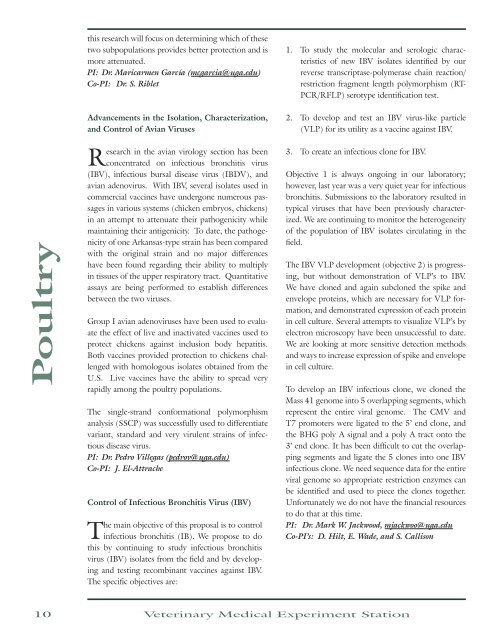Agroterrorism - University of Georgia College of Veterinary Medicine
Agroterrorism - University of Georgia College of Veterinary Medicine
Agroterrorism - University of Georgia College of Veterinary Medicine
- No tags were found...
Create successful ePaper yourself
Turn your PDF publications into a flip-book with our unique Google optimized e-Paper software.
this research will focus on determining which <strong>of</strong> thesetwo subpopulations provides better protection and ismore attenuated.PI: Dr. Maricarmen García (mcgarcia@uga.edu)Co-PI: Dr. S. Riblet1. To study the molecular and serologic characteristics<strong>of</strong> new IBV isolates identified by ourreverse transcriptase-polymerase chain reaction/restriction fragment length polymorphism (RT-PCR/RFLP) serotype identification test.PoultryAdvancements in the Isolation, Characterization,and Control <strong>of</strong> Avian VirusesResearch in the avian virology section has beenconcentrated on infectious bronchitis virus(IBV), infectious bursal disease virus (IBDV), andavian adenovirus. With IBV, several isolates used incommercial vaccines have undergone numerous passagesin various systems (chicken embryos, chickens)in an attempt to attenuate their pathogenicity whilemaintaining their antigenicity. To date, the pathogenicity<strong>of</strong> one Arkansas-type strain has been comparedwith the original strain and no major differenceshave been found regarding their ability to multiplyin tissues <strong>of</strong> the upper respiratory tract. Quantitativeassays are being performed to establish differencesbetween the two viruses.Group I avian adenoviruses have been used to evaluatethe effect <strong>of</strong> live and inactivated vaccines used toprotect chickens against inclusion body hepatitis.Both vaccines provided protection to chickens challengedwith homologous isolates obtained from theU.S. Live vaccines have the ability to spread veryrapidly among the poultry populations.The single-strand conformational polymorphismanalysis (SSCP) was successfully used to differentiatevariant, standard and very virulent strains <strong>of</strong> infectiousdisease virus.PI: Dr. Pedro Villegas (pedrov@uga.edu)Co-PI: J. El-AttracheControl <strong>of</strong> Infectious Bronchitis Virus (IBV)The main objective <strong>of</strong> this proposal is to controlinfectious bronchitis (IB). We propose to dothis by continuing to study infectious bronchitisvirus (IBV) isolates from the field and by developingand testing recombinant vaccines against IBV.The specific objectives are:2. To develop and test an IBV virus-like particle(VLP) for its utility as a vaccine against IBV.3. To create an infectious clone for IBV.Objective 1 is always ongoing in our laboratory;however, last year was a very quiet year for infectiousbronchitis. Submissions to the laboratory resulted intypical viruses that have been previously characterized.We are continuing to monitor the heterogeneity<strong>of</strong> the population <strong>of</strong> IBV isolates circulating in thefield.The IBV VLP development (objective 2) is progressing,but without demonstration <strong>of</strong> VLP’s to IBV.We have cloned and again subcloned the spike andenvelope proteins, which are necessary for VLP formation,and demonstrated expression <strong>of</strong> each proteinin cell culture. Several attempts to visualize VLP’s byelectron microscopy have been unsuccessful to date.We are looking at more sensitive detection methodsand ways to increase expression <strong>of</strong> spike and envelopein cell culture.To develop an IBV infectious clone, we cloned theMass 41 genome into 5 overlapping segments, whichrepresent the entire viral genome. The CMV andT7 promoters were ligated to the 5’ end clone, andthe BHG poly A signal and a poly A tract onto the3’ end clone. It has been difficult to cut the overlappingsegments and ligate the 5 clones into one IBVinfectious clone. We need sequence data for the entireviral genome so appropriate restriction enzymes canbe identified and used to piece the clones together.Unfortunately we do not have the financial resourcesto do that at this time.PI: Dr. Mark W. Jackwood, mjackwoo@uga.eduCo-PI’s: D. Hilt, E. Wade, and S. Callison10<strong>Veterinary</strong> Medical Experiment Station
















